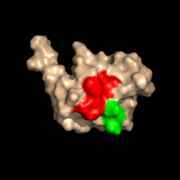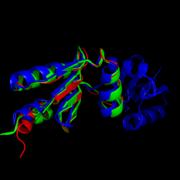Sandbox Reserved 1061
From Proteopedia
(Difference between revisions)
| Line 3: | Line 3: | ||
<StructureSection load='4hs1' size='300' side='right' caption='Micobacterium tuberculosis NrdH' scene='69/694228/Mtnrdh/2'> | <StructureSection load='4hs1' size='300' side='right' caption='Micobacterium tuberculosis NrdH' scene='69/694228/Mtnrdh/2'> | ||
== Overview == | == Overview == | ||
| - | ''Mycobacterium tuberculosis'' NrdH (MtNrdH) is a small glutaredoxin-like protein involved in the electron transport chain in ribonucleotide reduction. Therefore, it is extremely important in DNA production and replication because it helps supply cells with deoxyribonucleotides. Reduction of MtNrdH results in the breaking of an internal disulfide bond at the active site, allowing it to accept electrons and pass them on downstream. | + | ''Mycobacterium tuberculosis'' NrdH (MtNrdH) is a small glutaredoxin-like protein involved in the electron transport chain in ribonucleotide reduction. Therefore, it is extremely important in DNA production and replication because it helps supply cells with deoxyribonucleotides. Reduction of MtNrdH results in the breaking of an internal disulfide bond at the active site, allowing it to accept electrons and pass them on downstream. Due to its imperative role in ribionucleotide reduction, MtNrdH is thought to be essential to the reproductive integrity of ''M. tuberculosis'', suggesting its role in infectivity and leading to its identification as a possible drug target.<ref name ="Swastik">Swastik, Phulera and Mande, Shekhar C. (2013) The Crystal Structure of Mycobacterium tuberculosis NrdH at 0.87Å Suggests a Possible Mode of Its Activity. Biochemistry 52, 4056-4065.</ref> |
== Background == | == Background == | ||
| - | [http://en.wikipedia.org/wiki/Mycobacterium_tuberculosis ''Mycobacterium tuberculosis'']resides in the lungs of a host | + | [http://en.wikipedia.org/wiki/Mycobacterium_tuberculosis ''Mycobacterium tuberculosis'']resides in the lungs of a host. Upon becoming active, this bacterium results in a Tuberculosis infection (TB) and is the cause of symptoms such as chest pain, weakness, and intense coughing. Left untreated and unmanaged, TB can lead to death (1.5 million in 2013).<ref name="WHO">"Tuberculosis." Media Centre. World Health Organization, Web. 16 Mar. 2015. Media Centre. <http://www.who.int/mediacentre/factsheets/fs104/en/>.</ref> The disease has a high co-morbidity with HIV/AIDS due to its immunocompromising tendencies. TB is one of the most heavily studied diseases today. With over 9 million infections worldwide per year, the necessity for antimicrobial agents to combat emerging multi-drug resistant strands is imperative.<ref name="WHO" /> |
| Line 21: | Line 21: | ||
==== Conformational Changes ==== | ==== Conformational Changes ==== | ||
| - | Exactly how this structure relates to function is somewhat debated, but it is hypothesized that the fold allows residues preceding the turn to interact with the CVQC region after the turn. A threonine-7 reside directly across the thioredoxin fold from the disulfide bond has been suggested to adopt two different conformations which | + | Exactly how this structure relates to function is somewhat debated, but it is hypothesized that the fold allows residues preceding the turn to interact with the CVQC region after the turn. A threonine-7 reside directly across the thioredoxin fold from the disulfide bond has been suggested to adopt two different conformations which differently affect the redox abilities of the protein. In the <scene name='69/694228/Nrdh_ligand_binding_site/17'>"A" conformation</scene>, the alcohol oxygen of the threonine side chain (seen as a red ball) points towards the disulfide bond, forming an electrostatic interaction (represented by a short dashed line) between the two that prevents thioredoxin reductase (TrxR) from binding. Alternatively, in the <scene name='69/694228/Nrdh_ligand_binding_site/18'>"B" Conformation</scene>, the alcohol points in the opposite direction, allowing sufficient space and enough electrostatic freedom for the ligand to bind and reduction to occur.<ref name="Swastik" /> |
| - | [[Image:Hydrophobic region 2.png|thumb|right| '''Figure 2.'''Hydrophobic region WSGFRP on the surface of MtNrdH (red) next to the active site (green.) Notice that this Hydrophobic region is heavily exposed to solvent. | + | [[Image:Hydrophobic region 2.png|thumb|right| '''Figure 2.'''Hydrophobic region WSGFRP on the surface of MtNrdH (red) next to the active site (green.) Notice that this Hydrophobic region is heavily exposed to solvent. The WSGFRP sequence is thought to help thioredoxin reductase bind for reduction.<ref name="Swastik" /> <ref name="PyMol">The PyMOL Molecular Graphics System, Version 1.7.4 Schrödinger, LLC.</ref>]] |
| - | + | The WSGFRP sequence, which is also highly conserved (Figure 3), is a nonpolar sequence that can be found on the surface of the molecule and is exposed to solvent (Figure 2). For this reason, it has been hypothesized that this sequence plays a role in the binding of thioredoxin reductase.<ref name="Swastik" /> Nonpolar residues on thioredoxin reductase would interact with the hydrophobic region, thus holding the thioredoxin reductase in place during reduction. | |
<scene name='69/694227/Arg_68/4'>Arg-68</scene> is responsible for the stabilization of the hydrophobic region of NrdH. Arg-68 has two distinct conformations. In the <scene name='69/694227/Arg_68_conformation_1/4'>first conformation</scene>, Arg-68 is hydrogen bonded to His- 60 and Asp-59. When Arg-68 shifts to its <scene name='69/694227/Arg_68_conformation_2/5'>second conformation</scene>, it breaks its hydrogen bond with Asp-59. <ref name="Swastik" /> This reduction in hydrogen bonding gives the hydrophobic region more flexibility and is thought to occur when NrdH is in its inactive state. | <scene name='69/694227/Arg_68/4'>Arg-68</scene> is responsible for the stabilization of the hydrophobic region of NrdH. Arg-68 has two distinct conformations. In the <scene name='69/694227/Arg_68_conformation_1/4'>first conformation</scene>, Arg-68 is hydrogen bonded to His- 60 and Asp-59. When Arg-68 shifts to its <scene name='69/694227/Arg_68_conformation_2/5'>second conformation</scene>, it breaks its hydrogen bond with Asp-59. <ref name="Swastik" /> This reduction in hydrogen bonding gives the hydrophobic region more flexibility and is thought to occur when NrdH is in its inactive state. | ||
| Line 48: | Line 48: | ||
Like most NrdHs, MtNrdH is similar in sequence to glutaredoxins, but structurally similar to thioredoxins (Figure 6). MtNrdH also accepts electrons from thioredoxin reductase, a characteristic of thioredoxins, but not glutaredoxins.<ref name="Swastik" /> [[Image:Image-Super imposed molecules.png|thumb|left|'''Figure 6.'''Structural comparison of NrdHs with "thioredoxin folds": ''E. Coli'' NrdH (green), ''C. ammoniagenes'' NrdH (blue), ''M. tuberculosis'' NrdH (red)<ref name="PyMol" />]] | Like most NrdHs, MtNrdH is similar in sequence to glutaredoxins, but structurally similar to thioredoxins (Figure 6). MtNrdH also accepts electrons from thioredoxin reductase, a characteristic of thioredoxins, but not glutaredoxins.<ref name="Swastik" /> [[Image:Image-Super imposed molecules.png|thumb|left|'''Figure 6.'''Structural comparison of NrdHs with "thioredoxin folds": ''E. Coli'' NrdH (green), ''C. ammoniagenes'' NrdH (blue), ''M. tuberculosis'' NrdH (red)<ref name="PyMol" />]] | ||
| - | Similar structures of NrdH have been isolated in other primitive species including ''E. coli'', ''S. pyogenes'', ''S. typhimurium'', ''D. deserti'', ''S. flexneri 2457T'', ''S. dysenteriae'', and ''C. glutamicium''<ref>Wang, M. et al. Mol Cell Proteomics 2012, doi:10.1074/mcp.O111.014704. http://pax-db.org/#!search?q=NrdH%250A</ref> <ref>Si, M.-R., Zhang, L., Yang, Z.-F., Xu, Y.-X., Liu, Y.-B., Jiang, C.-Y., … Liu, S.-J. (2014). NrdH Redoxin Enhances Resistance to Multiple Oxidative Stresses by Acting as a Peroxidase Cofactor in Corynebacterium glutamicum. Applied and Environmental Microbiology, 80(5), 1750–1762. doi:10.1128/AEM.03654-13</ref> In higher order multi-cellular organisms, however the NrdH protein is replaced by more complex glutaredoxins or thioredoxins. This observation leads some to speculate that NrdH is one of the very first ancestors in the ribonucleotide reduction pathway. <ref name="Swastik" /> If this is true, NrdH can be seen as a critical protein that allowed for the development of DNA-based life since deoxyribonucleotides could not have existed without the ribonucleotide reduction pathway. A better understanding of the evolutionary timeline of NrdH and similar proteins could shed greater light onto the [http://en.wikipedia.org/wiki/RNA_world RNA Wold Hypothesis], specifically describing the time frame of emergence of DNA based life. | + | Similar structures of NrdH have been isolated in other primitive species including ''E. coli'', ''S. pyogenes'', ''S. typhimurium'', ''D. deserti'', ''S. flexneri 2457T'', ''S. dysenteriae'', and ''C. glutamicium''<ref>Wang, M. et al. Mol Cell Proteomics 2012, doi:10.1074/mcp.O111.014704. http://pax-db.org/#!search?q=NrdH%250A</ref> <ref>Si, M.-R., Zhang, L., Yang, Z.-F., Xu, Y.-X., Liu, Y.-B., Jiang, C.-Y., … Liu, S.-J. (2014). NrdH Redoxin Enhances Resistance to Multiple Oxidative Stresses by Acting as a Peroxidase Cofactor in Corynebacterium glutamicum. Applied and Environmental Microbiology, 80(5), 1750–1762. doi:10.1128/AEM.03654-13</ref> In higher order multi-cellular organisms, however, the NrdH protein is replaced by more complex glutaredoxins or thioredoxins. This observation leads some to speculate that NrdH is one of the very first ancestors in the ribonucleotide reduction pathway. <ref name="Swastik" /> If this is true, NrdH can be seen as a critical protein that allowed for the development of DNA-based life since deoxyribonucleotides could not have existed without the ribonucleotide reduction pathway. A better understanding of the evolutionary timeline of NrdH and similar proteins could shed greater light onto the [http://en.wikipedia.org/wiki/RNA_world RNA Wold Hypothesis], specifically describing the time frame of emergence of DNA based life. |
==Possible Drug Target== | ==Possible Drug Target== | ||
| - | MtNrdH can serve as a potential drug target to treat tuberculosis. The genes encoding NrdE and NrdF2, a cofactor in class 1b ribonucleotide reduction, are essential for growth of M. tuberculosis in vitro.<ref>Mowa, M. B., et al. (2009) Function and regulation of class I ribonucleotide reductase-encoding genes in mycobacteria. J. Bacteriol. 191 (3), 985−995</ref> This suggests that M. tuberculosis relies solely on class Ib ribonucleotide reduction. If that is the case, NrdH may be an essential gene as well. Since NrdH is not found in humans, a drug that targets NrdH would be able to damage M. tuberculosis cells without hurting the human host. | + | MtNrdH can serve as a potential drug target to treat tuberculosis. The genes encoding NrdE and NrdF2, a cofactor in class 1b ribonucleotide reduction, are essential for growth of M. tuberculosis in vitro.<ref>Mowa, M. B., et al. (2009) Function and regulation of class I ribonucleotide reductase-encoding genes in mycobacteria. J. Bacteriol. 191 (3), 985−995</ref> This suggests that M. tuberculosis relies solely on class Ib ribonucleotide reduction. If that is the case, NrdH may be an essential gene as well. Since NrdH is not found in humans, a drug that targets NrdH would be able to damage M. tuberculosis cells without hurting the human host. |
</StructureSection> | </StructureSection> | ||
Revision as of 19:21, 26 April 2015
| This Sandbox is Reserved from 02/09/2015, through 05/31/2016 for use in the course "CH462: Biochemistry 2" taught by Geoffrey C. Hoops at the Butler University. This reservation includes Sandbox Reserved 1051 through Sandbox Reserved 1080. |
To get started:
More help: Help:Editing |
Structure of Mycobacterium Tuberculosis NrdH
| |||||||||||
References
- ↑ 1.0 1.1 1.2 1.3 1.4 1.5 1.6 1.7 1.8 Swastik, Phulera and Mande, Shekhar C. (2013) The Crystal Structure of Mycobacterium tuberculosis NrdH at 0.87Å Suggests a Possible Mode of Its Activity. Biochemistry 52, 4056-4065.
- ↑ 2.0 2.1 "Tuberculosis." Media Centre. World Health Organization, Web. 16 Mar. 2015. Media Centre. <http://www.who.int/mediacentre/factsheets/fs104/en/>.
- ↑ 3.0 3.1 Crooks GE, Hon G, Chandonia JM, Brenner SE WebLogo: A sequence logo generator, Genome Research, 14:1188-1190, (2004)
- ↑ 4.0 4.1 The PyMOL Molecular Graphics System, Version 1.7.4 Schrödinger, LLC.
- ↑ 5.0 5.1 Kolberg, M., et al. (2004) Structure, function, and mechanism of ribonucleotide reductases. Biochim. Biophys. Acta 1699 (1−2), 1−34.
- ↑ Nelson, David L., and Michael M. Cox. Lehninger Principles of Biochemistry. 5th ed. New York: W.H. Freeman, 2008. 888-889.
- ↑ 7.0 7.1 Makhlynets, O., Boal, A. K., Rhodes, D. V., Kitten, T., Rosenzweig, A. C., & Stubbe, J. (2014). Streptococcus sanguinis Class Ib Ribonucleotide Reductase: HIGH ACTIVITY WITH BOTH IRON AND MANGANESE COFACTORS AND STRUCTURAL INSIGHTS. The Journal of Biological Chemistry, 289(9), 6259–6272. doi:10.1074/jbc.M113.533554.
- ↑ Arne Holmgren, Thioredoxin structure and mechanism: conformational changes on oxidation of the active-site sulfhydryls to a disulfide, Structure, Volume 3, Issue 3, March 1995, Pages 239-243, ISSN 0969-2126, http://dx.doi.org/10.1016/S0969-2126(01)00153-8.
- ↑ Wang, M. et al. Mol Cell Proteomics 2012, doi:10.1074/mcp.O111.014704. http://pax-db.org/#!search?q=NrdH%250A
- ↑ Si, M.-R., Zhang, L., Yang, Z.-F., Xu, Y.-X., Liu, Y.-B., Jiang, C.-Y., … Liu, S.-J. (2014). NrdH Redoxin Enhances Resistance to Multiple Oxidative Stresses by Acting as a Peroxidase Cofactor in Corynebacterium glutamicum. Applied and Environmental Microbiology, 80(5), 1750–1762. doi:10.1128/AEM.03654-13
- ↑ Mowa, M. B., et al. (2009) Function and regulation of class I ribonucleotide reductase-encoding genes in mycobacteria. J. Bacteriol. 191 (3), 985−995






